
One year ago, when I was 23 years old, I learned that I have metastatic breast cancer that has spread to my sternum, spine, and pelvis. Metastatic cancer is cancer that has spread from its original location to another body part. It is sometimes called advanced cancer or stage 4 cancer.
I am among the 10% of women who are initially diagnosed with metastatic breast cancer. It was the last thing I expected. Other than being female, I have none of the risk factors for breast cancer: I am very young, thin, physically active and fit. I have never used any hormonal medications; I don’t smoke, drink, or use drugs; I eat a healthy diet. Genetic testing indicated I do not carry the breast cancer genes. I was never diagnosed with stage 0, I, II or III breast cancer; but I have metastatic breast cancer.
Metastasis is what makes breast cancer a deadly disease. It is the leading cause of death in young women with breast cancer. In fact, every day 108 American women die from metastatic breast cancer. This is over 40,000 women each year and this number has held steady for the last 15 years. If a cure is not found soon, one day it will be me.
Billions of dollars are raised for breast cancer, but only 2% goes toward research to find a cure for those with metastatic breast cancer. Most of the money raised is spent on awareness, early detection, and treatments for early stages of breast cancer. Early detection does not guarantee a cure, and being told one has been “successfully” treated” for early stage breast cancer does not mean that one never has to worry about cancer again. It only means that at present, they cannot see one’s cancer. Cancer cells can disseminate undetected and then lie dormant for a very long time before they activate. Thus metastatic breast cancer can occur many years after the patient’s original diagnosis and treatment.
Until a cure is found for metastatic breast cancer, no one with breast cancer can ever be certain they won’t die of breast cancer, even after both breasts have been removed and no cancer is detected following surgery. Our current technology cannot detect whether very tiny breast cancer stem cells have traveled to a new body part. These cancer cells sometimes begin growing after surgery, radiation, and chemotherapy have been completed. In fact, this will happen to about 30% of the women who were successfully treated for early stages of breast cancer. Months, years, or even decades later, they will develop stage 4 breast cancer and die. It is a possibility that no one wants to talk about. It is the elephant in every breast cancer patient’s room.
Please help raise awareness and funds for Metastatic Breast Cancer Research by joining me in the Turning Challenge. Let’s send a message to breast cancer fundraising operations to turn around and look at us Stage 4 patients; we deserve more than 2 percent.
The Turning Challenge can be fun for everyone: both dancers and non-dancers. All that you have to do is post a video of spinning or rotating in some fashion. It can be as simple as the Hokie Pokie or as difficult as 32 fouettes. You can hold a spinning object like a pinwheel or film your pet dog chasing his tail. There are no rules!
Inspire, entertain, amuse – or just make us smile! Be creative!
Please use #TheTurningChallenge and nominate three or more friends. If you prefer not to complete the challenge, please make a donation to METAvivor where 100% of your donation will go to metastatic breast cancer research. You can do this at the following link: https://secure.metavivor.org/page/contribute/default. Of course, nothing prevents you from “turning” AND donating to METAvivor!
Help make this a Turning Point for metastatic breast cancer research.
The Turning Point Video: